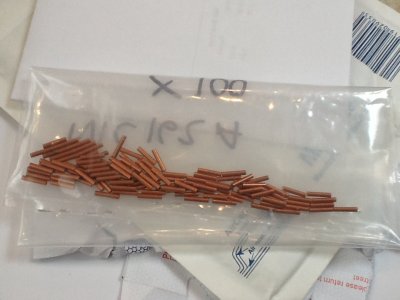No need, John - Allie and Maillard did. Look at the original
I have nabbed a bunch of photos of the oldies, but had never noted that Olė. Thanks ;-)
No need, John - Allie and Maillard did. Look at the original
John, Great deal on the rounding jack, good luck with it. Also I use bee's wax.If you need photos of tool's and I can help just let me know
Nice find John. Good luck with it!




You're more than welcome, Richard. Not the #108, it looked like in the seller's pictures, but I hope it'll work out anyway. Also hope you win the 7 3/8 too
What numbers do you find on the flange?
Called a "dent clamp" in the book.

Check these out on eBay. I bought them. 500 should last me until I retire from my present career & become a real hatter ;-)
http://bit.ly/1jvaRh6
Okay, I know that Allie and Maillard are probably spinning in their graves over this one, but I built it anyway and surprise...it actually works. My first homemade conformateur. My apologies to the ghosts of the original inventors, but I can't afford to buy the real thing. View attachment 10072
Thank you, I've ordered some from a theatrical chandler in the UK. Not quite sure what a theatrical chandler is but they look very similar to these!
 John Lofgren Monkey Boots Shinki Horsebuttt - $1,136 The classic monkey boot silhouette in an incredibly rich Shinki russet horse leather.
John Lofgren Monkey Boots Shinki Horsebuttt - $1,136 The classic monkey boot silhouette in an incredibly rich Shinki russet horse leather.  Grant Stone Diesel Boot Dark Olive Chromexcel - $395 Goodyear welted, Horween Chromexcel, classic good looks.
Grant Stone Diesel Boot Dark Olive Chromexcel - $395 Goodyear welted, Horween Chromexcel, classic good looks.  Schott 568 Vandals Jacket - $1,250 The classic Perfecto motorcycle jacket, in a very special limited-edition Schott double rider style.
Schott 568 Vandals Jacket - $1,250 The classic Perfecto motorcycle jacket, in a very special limited-edition Schott double rider style. John Galt- you seem to be a bit of a woodworker, for flanges take a block trace the outer edge onto a doubled up piece of poplar or basswood (flip flop your grain to prevent checking)you can follow the edge with a scribe for exact size or hold a pencil tight to the side of block and follow around you can gain 1/8" or 1/4" to your inside dimension. I would use a plunge router with a straight cut then use a rounding over bit to get your curve for outer and inner edge. Very little sanding top only.
Band saw is good for outer only than you have to use a saber saw for inner. I have taken brim flange cut it in half then I make spacers to fit between two halves to achieve the dimension I want. I use two pieces of parachute cord to one hold the flange together and one to secure flannel for ironing. Bought too many blocks and flanges and you never really have what you need! Wool felt is another way to expand the sizes of your block collection,it also makes a nice crisp edge crown to brim. Good luck on your jack look at old wooden hangars for the curve to follow around the bottom of the crown. Hope this helps
The hard part is the curve of the upper-side of the flange. This curve is what defines the flange, and it is very different from flange-model to flange-model. On flanges for snap-brims, the curve is even different in the front and back of the same flange. One has to have a lot of knowledge on flanges (and/or hatting) to make flanges - and the same goes for blocks. It takes a lot more than "just" wood-working skills to make flanges and blocks
Traditionally a (ship) chandler is a shop, dealing with rope, tools, tar, clothes and even food for the shipping industry. The word "chandler" was probably imported into the theatre industry by retired sailors - the main source for earlier days' stage-hands and theatre-technicians. Anyway, I have often heard English spoken former colleagues call a technical supplier, "a chandler"
